Related Research Articles
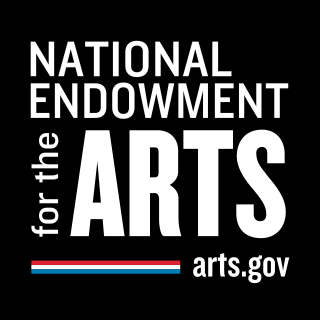
The National Endowment for the Arts (NEA) is an independent agency of the United States federal government that offers support and funding for projects exhibiting artistic excellence. It was created in 1965 as an independent agency of the federal government by an act of the U.S. Congress, signed by President Lyndon B. Johnson on September 29, 1965. It is a sub-agency of the National Foundation on the Arts and the Humanities, along with the National Endowment for the Humanities, the Federal Council on the Arts and the Humanities, and the Institute of Museum and Library Services.
Jerry Edward Hunt was an American composer who created works using live electronics partly controlled by his ritualistic performance techniques which were influenced by his interest in the occult. He was considered a pioneer of live, electronic and computer-aided audio and video. Hunt lived his entire life in Texas, living in a house he built himself on his family's ranchland. For Hunt, it was financially necessary to live in Texas, but almost impossible to create a career within the state. Hunt was often described as "hyperactive" and always on the move. He was also often either chewing on tobacco or chewing gum. He often dressed conservatively, in a suit or button-up shirt and tie. He was said to have a "wicked sense of humor."
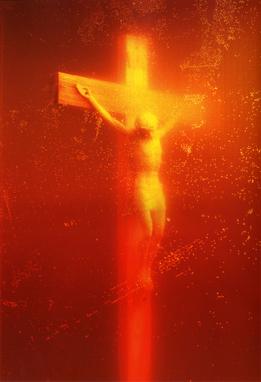
Immersion (Piss Christ) is a 1987 photograph by the American artist and photographer Andres Serrano. It depicts a small plastic crucifix submerged in a small glass tank of the artist's urine. The piece was a winner of the Southeastern Center for Contemporary Art's "Awards in the Visual Arts" competition, which was sponsored in part by the National Endowment for the Arts, a United States Government agency that offers support and funding for artistic projects.
Ron Athey is an American performance artist associated with body art and with extreme performance art. He has performed in the U.S. and internationally. Athey's work explores challenging subjects like the relationships between desire, sexuality and traumatic experience. Many of his works include aspects of S&M in order to confront preconceived ideas about the body in relation to masculinity and religious iconography.
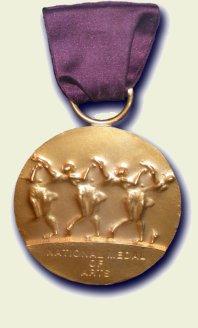
The National Medal of Arts is an award and title created by the United States Congress in 1984, for the purpose of honoring artists and patrons of the arts. A prestigious American honor, it is the highest honor given to artists and arts patrons by the United States government. Nominations are submitted to the National Council on the Arts, the advisory committee of the National Endowment for the Arts (NEA), who then submits its recommendations to the White House for the President of the United States to award. The medal was designed for the NEA by sculptor Robert Graham.
John Fleck is an American actor and performance artist. He has performed in numerous TV shows, including Babylon 5, Carnivàle, Murder One, and the Star Trek franchise. He also appeared in Howard The Duck, Waterworld and the music video for the ZZ Top song "Legs". He made a minor appearance in the Seinfeld episode "The Heart Attack". He played a minor character during the sixth season of Weeds. He wrote and performed "Mad Women" at La MaMa E.T.C.

John Frohnmayer is a retired attorney from the U.S. state of Oregon. He was the fifth chairman of the National Endowment for the Arts, a program of the United States government. He was appointed by President George H. W. Bush in 1989, and served until 1992.

Karen Finley is an American performance artist, musician and poet. Her performance art, recordings, and books are used as forms of activism. Her work frequently uses nudity and profanity. Finley incorporates depictions of sexuality, abuse, and disenfranchisement in her work She is currently a professor at the Tisch School of the Arts at New York University.

John Patrick Williams is an American Democratic legislator who represented Montana in the United States House of Representatives from 1979 to 1997.
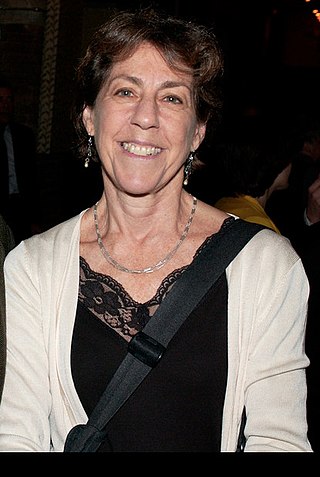
Marjorie Heins (b.1946) is a First Amendment lawyer, writer and founder of the Free Expression Policy Project.
Holly Hughes is an American lesbian performance artist.
Arts administration is a field in the arts sector that facilitates programming within cultural organizations. Arts administrators are responsible for facilitating the day-to-day operations of the organization as well as the long term goals by and fulfilling its vision, mission and mandate. Arts management became present in the arts and culture sector in the 1960s. Organizations include professional non-profit entities. For examples theaters, museums, symphonies, jazz organizations, opera houses, ballet companies and many smaller professional and non-professional for-profit arts-related organizations. The duties of an arts administrator can include staff management, marketing, budget management, public relations, fundraising, program development evaluation, and board relations.

Bill Lichtenstein is an American print and broadcast journalist and documentary producer, president of the media production company, Lichtenstein Creative Media, Incorporated.
The Oregon Arts Commission is a governor-appointed body of nine commissioners who allocate grants for artists based in the U.S. state of Oregon. It receives the bulk of its funding through the National Endowment for the Arts, the state, and the Oregon Cultural Trust. The commission provides funding for local artists through their fellowship programs.
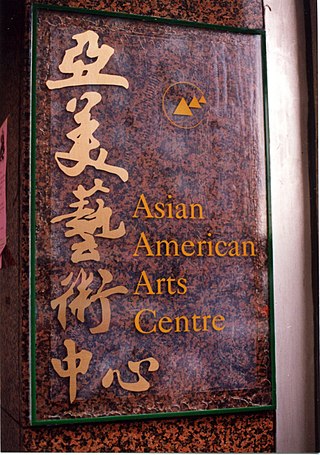
The Asian American Arts Centre (AAAC) is a non-profit organization located in Chinatown in New York City. Founded in 1974, it is one of the earliest Asian American community organizations in the United States. The Arts Centre presents the ongoing developments between contemporary Asian & Asian American art forms and Western art forms through the presentation of performance, exhibitions, and public education. AAAC's permanent collection, which it has accumulated since 1989, contains hundreds of contemporary Asian American art works and traditional/folk art pieces. The organization also has an Artists Archive which documents, preserves, and promotes the presence of Asian American visual culture in the United States since 1945. This includes the East Coast, especially the greater New York area; the West Coast; and some artists in Canada, Hawaii, and overseas. The artists include Asian Americans producing art, Asian artists who are active in the United States, and other Americans who are significantly influenced by Asia. Pan-Asian in outlook, the Arts Centre's understanding of ‘Asia’ encompasses traditions and influences with sources ranging from Afghanistan to Hawaii.
Ronald Jones was an American artist, critic and educator who gained prominence in New York City during the mid-1980s. In the magazine Contemporary, Brandon Labelle wrote: "Working as an artist, writer, curator, professor, lecturer and critic over the last 20 years, Jones is a self-styled Conceptualist, spanning the worlds of academia and art, opera and garden design, and acting as paternal spearhead of contemporary critical practice. Explorative and provocative, Jones creates work that demands attention that is both perceptual and political." Labelle positions Jones along the leading edge of a "contemporary critical practice" that is perhaps best described as interdisciplinary or transdisciplinary.

Franklin Furnace Archive, Inc. is an arts organization-in-residence at Pratt Institute in Brooklyn, New York. Since its inception in 1976, Franklin Furnace has been identifying, presenting, archiving, and making avant-garde art available to the public. Franklin Furnace focuses on time-based art forms that may be vulnerable due to institutional neglect, cultural bias, politically unpopular content or their ephemeral or experimental nature. Franklin Furnace is dedicated to serving emerging artists by providing both physical and virtual venues for the presentation of time-based art, including but not limited to artists' books and periodicals, site-specific installations, performance art, and live art on the internet.
National Endowment for the Arts v. Finley, 524 U.S. 569 (1998), was a United States Supreme Court case in which the Court ruled that the National Foundation on the Arts and Humanities Act, as amended in 1990,, was facially valid, as it neither inherently interfered with First Amendment rights nor violated constitutional vagueness principles. The act in question required the Chairperson of the National Endowment for the Arts (NEA) to ensure that "artistic excellence and artistic merit are the criteria by which [grant] applications are judged, taking into consideration general standards of decency and respect for the diverse beliefs and values of the American public". Justice O'Connor delivered the opinion of the Court.
The Perfect Moment was the most comprehensive retrospective of works by New York photographer Robert Mapplethorpe. The show spanned twenty-five years of his career, featuring celebrity portraits, self-portraits, interracial figure studies, floral still lifes, homoerotic images, and collages. The exhibition, organized by Janet Kardon of the Institute of Contemporary Arts in Philadelphia, opened in the winter of 1988 just months before Mapplethorpe's death from AIDS complications on March 9, 1989. On tour, in the summer of 1989, the exhibition became the centerpiece of a controversy concerning federal funding of the arts and censorship.
Merry Alpern is an American photographer whose work has been shown in museums and exhibitions around the country including the Whitney Museum of American Art, San Francisco Museum of Modern Art, Museum of Modern Art, National Museum of Women in the Arts, and The Museum of Fine Arts, Houston. Her most notable work is her 1993-94 series Dirty Windows, a controversial project in which she took photos of an illegal sex club through a bathroom window in Manhattan near Wall Street. In 1994, the National Endowment for the Arts rejected recommended photography fellowships to Alpern, as well as Barbara DeGenevieve and Andres Serrano. Merry Alpern became one of many artists assaulted by congressional conservatives trying to defund the National Endowment for the Arts because of this series. As a result, museums such as the Museum of Modern Art in New York and San Francisco rushed to exhibit the series. She later produced and exhibited another series called Shopping which included images from hidden video cameras, taken in department stores, malls, and fitting rooms between 1997-99.
References
- ↑ Tallmer, Jerry (2003-10-02). "Vagina Dentata Monologue". Gay City News . New York, NY, US. Archived from the original on 2005-11-10. Retrieved 23 February 2013.
'I guess you could blame us for that,' Fleck admitted. 'But if it wasn't us, it would have been someone else.'
- ↑ National Endowment for the Arts v. Finley, 524 U.S. 569, (1998)
- ↑ Creative, Commons. "Policymaking, Power, and Accountability in the Bureaucracy".
- ↑ Koch, Cynthia. "The Contest for American Culture: A Leadership Case Study on The NEA and NEH Funding Crisis".
- ↑ Honan, William (4 May 2002). "Book Discloses That Reagan Planned To Kill National Endowment for Arts". New York Times.
- ↑ Balfe, Judith Huggins, ed. (1993). Paying the Piper : Causes and Consequences of Art Patronage. Urbana, IL, US: University of Illinois Press. pp. 254–67. ISBN 0-252-06310-4. LCCN 92038280. OCLC 27220304. Archived from the original on 2015-04-30.
- ↑ Kramer, Hilton (July 2, 1989). "Is Art Above The Laws of Decency?". New York Times.
- ↑ Shockley, Gordon E. (2011). "Political Environment And Policy Change: The National Endowment For The Arts In The 1990s". Journal of Arts Management, Law & Society. 4 (41): 267–84. doi:10.1080/10632921.2011.628232. S2CID 144660729.
- ↑ "Comments on Andres Serrano by Members of the US Senate".
- 1 2 Bolton, Richard (1992). Culture Wars: Documents from the Recent Controversy in the Arts . New York: The New Press. ISBN 978-1-56584-011-9. LCCN 91066861. OCLC 26652907.
{{cite book}}: CS1 maint: url-status (link)